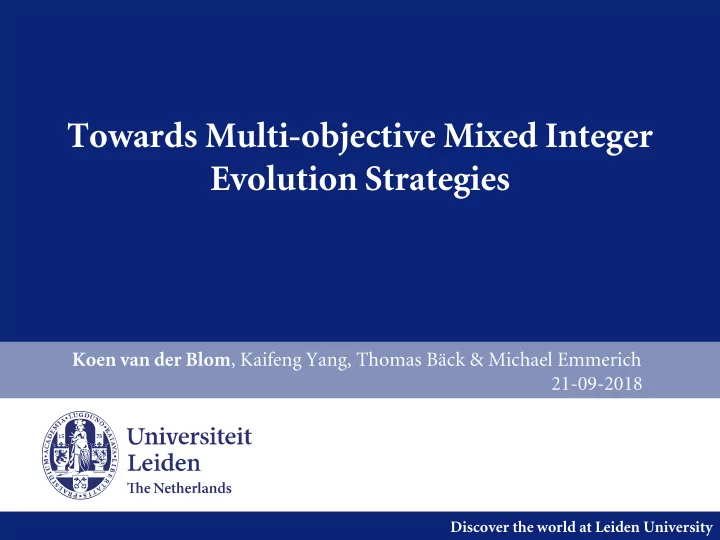

Towards Multi-objective Mixed Integer Evolution Strategies Koen van der Blom , Kaifeng Yang, Thomas Bäck & Michael Emmerich 21-09-2018 Discover the world at Leiden University
Motivation • Mixed Integer Evolution Strategy [Li et al 2013] • Real, integer, categorical • Single objective • Existing multi-objective techniques • Weight space decomposition (MILP) [Przybylski et al 2010] • Enhanced Directed Search (EDS) [Laredo 2015] • Zigzag [Wang 2013, Wang 2015] • No distinction between integer and categorical! • Extend MIES for multiple objectives 2 Discover the world at Leiden University
Evolution Strategies • Mimic evolution for optimisation • Parents generate offspring (recombination) • Offspring add additional variation (mutation) • Optimal mutation strength? • Changes over time… • Step size adaptation • Same evolutionary mechanisms! 3 Discover the world at Leiden University
(𝝂 + 𝝁) Evolution Strategy [Schwefel 1981] • 𝜈 parents generate 𝜇 offspring • Update decision variables • Update mutation probabilities • Select the best from 𝜈 ∪ 𝜇 • Repeat 4 Discover the world at Leiden University
Mixed Integer Evolution Strategy [Li et al 2013] Continuous Variables (Normal Distribution) Integer Variables (Geometrical Distribution) Categorical Variables 5 Discover the world at Leiden University
Mutation operators • Properties • Scalability (scale step size) • Asymmetry (maximal entropy, avoid bias) • Infinite support (every solution is reachable) • Example • Mutation of integer variables [Rudolph 1994] • Difference of two Geometric distributions Image from [Li et al 2013] 6 Discover the world at Leiden University
Multi-objective optimisation Train Routing • Time Min • Price Min Time TICKET SPEED CHANGE PRICE S OPT1 3:00 H 2 60 EUR OPT2 3:00 H 1 65 EUR OPT3 3:30 H 3 44 EUR Pareto front OPT4 4:30 H 2 41 EUR OPT5 15:30 4 35 EUR Price OPT6 15:34 4 32 EUR 7 Discover the world at Leiden University
SMS-EMOA [Emmerich et al 2005] • Optimise hypervolume indicator • Rank solutions • Non-dominated sorting • Hypervolume contribution 8 Discover the world at Leiden University
Hypervolume indicator • Measure the dominated region Image from [Emmerich+Deutz 2018] 9 Discover the world at Leiden University
𝑻 -metric (hypervolume) selection • Hypervolume contribution Image from [Emmerich+Deutz 2018] 10 Discover the world at Leiden University
Non-dominated sorting Time 2nd non-dominated front Pareto front Price 11 Discover the world at Leiden University
Multi-Objective MIES • Canonical MIES operators • 𝑇 -metric selection • Non-dominated sorting • (𝜈 + 1) strategy • Always select the 𝜈 best • (HV never decreases) 12 Discover the world at Leiden University
Alternative MO-MIES algorithms • Mutation only • Best results without recombination [Wessing et al 2017] • Different optimal step size for different directions Time Pareto front Price • Mutation tournament • Greater selection pressure 13 Discover the world at Leiden University
Scalable Test Problems • Multi-sphere • Multi-barrier • Optical filter • Layers (on/off) • Thickness per layer Image from [Li et al 2013] 14 Discover the world at Leiden University
Experimental setup • 10,000 evaluations • 25 repetitions 15 Discover the world at Leiden University
Optical filter convergence 16 Discover the world at Leiden University
Barrier convergence 17 Discover the world at Leiden University
Step size adaptation (multisphere) 18 Discover the world at Leiden University
Step size adaptation – Categorical 19 Discover the world at Leiden University
Future work • Improve categorical step size adaptation • Investigate recombination behaviour • Why does it work? • When will it not work? • Introduce multi-objective recombination? • Investigate integer step size adaptation • Can we prevent regressive behaviour? 20 Discover the world at Leiden University
Summary • Goal : • Extend the MIES algorithm for the multi-objective case • Plan : • Evaluate MIES + SMS-EMOA (= MOMIES) • Evaluate mutation only variant • Evaluate mutation tournament variant • Result : • Best performance for canonical MOMIES • Step size in continuous and integer space adapts quite well • Chaotic step size behaviour in categorical space • Future : • Improve categorial step size adaptation • Investigate recombination behaviour 21 Discover the world at Leiden University
References I • [Emmerich et al 2005] M. Emmerich, N. Beume, and B. Naujoks , “An EMO algorithm using the hypervolume measure as selection criterion,” in Evolutionary Multi -Criterion Optimization, edited by C. A. Coello Coello , A. Hernández Aguirre, and E. Zitzler (Springer Berlin Heidelberg, Berlin, Heidelberg, 2005), pp. 62 – 76. • [Emmerich+Deutz 2018] M. T. M. Emmerich and A. H. Deutz, Natural Computing 17, 585 – 609Sep (2018). • [Laredo 2015] D. Laredo Razo, EDS: A Continuation Method for Mixed-Integer Multi- objective Optimization Problems, Master’s thesis, CINVESTAV -IPN, Mexico City (2015). • [Li et al 2013] R. Li, M. T. M. Emmerich, J. Eggermont, T. Bäck , M. Schütz , J. Dijkstra, and J. H. C. Reiber, Evolutionary computation 21, 29 – 64 (2013). • [Przybylski 2010] A. Przybylski, X. Gandibleux, and M. Ehrgott, INFORMS Journal on Computing 22, 371 – 386 (2010). • [Rudolph 1994] G . Rudolph, “An evolutionary algorithm for integer programming,” in Parallel Problem Solving from Nature — PPSN III, edited by Y. Davidor, H.-P. Schwefel, and R. Männer (Springer Berlin Heidelberg, Berlin, Heidelberg, 1994), pp. 139 – 148. • [Schwefel 1981] Hans-Paul Schwefel. Numerical Optimization of Computer Models. John Wiley & Sons, Inc., New York, NY, USA, 1981. • [Wang 2015] H. Wang, Computers & Operations Research 61, 100 – 09 (2015). 22 Discover the world at Leiden University
References II • [Wessing et al 2017] S. Wessing, R. Pink, K. Brandenbusch , and G. Rudolph, “Toward step - size adaptation in evolutionary multi- objective optimization,” in Evolutionary Multi - Criterion Optimization, edited by H. Trautmann, G. Rudolph, K. Klamroth, O. Schütze , M. Wiecek, Y. Jin, and C. Grimme (Springer International Publishing, Cham, 2017), pp. 670 – 684. 23 Discover the world at Leiden University
Sphere convergence 24 Discover the world at Leiden University
Step size adaptation 25 Discover the world at Leiden University
Recommend
More recommend